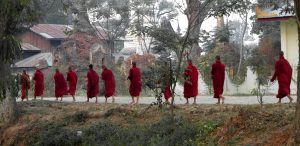Fears that the junta in Myanmar is attempting to trigger a holy war between the Buddhist clergy and anti-regime forces have resurfaced after two monks were shot dead, crimes that the military initially blamed on the rebels.
The dead included Sayadaw Bhaddanta Munindabhivamsa. He was a 78-year-old senior abbot from the Win Neinmitayon Monastery in Bago Region, who was shot and killed by soldiers from a truck while his car was driving out of Mandalay International Airport last week.
His driver lost three fingers in the attack while fellow monk Sayadaw Bhaddanta Gunikabhivamsa sustained head injuries from the smashed glass. His phone was confiscated by those who fired and then fled before other soldiers arrived and interrogated him at a camp in Mandalay Palace for five hours.
As the questioning continued, Gunikabhivamsa’s wounds went untreated and broadcaster MRTV declared that Munindabhivamsa had been killed by the opposition People’s Defense Force (PDF) during a firefight with the military. One suggestion was that the PDF had lobbed a landmine at the two monks.
That was patently untrue and junta spokesperson Maj. Gen. Zaw Min Tun subsequently admitted as much, and even apologized and promised to investigate. But according to PDF sources that apology was issued because of the mounting evidence to the contrary and Munindabhivamsa’s seniority.
PDF sources said that the hapless soldiers had no idea they had killed a senior monk from the Samgha Samagga, a Mandalay-based association that ranks among the highest of Buddhist authorities in Myanmar, which immediately condemned the killing as an act of terrorism.
Nor did they count on video footage of the killings going viral on social media or the tenacity of his friend Gunikabhivamsa, who went on television and explained what happened. The reportage that followed and the killing of a second monk on Saturday night added to the justified hype.
A PDF source and the Voice of Spring, a local online news portal, said village school teacher and monk U Uttama was shot dead – also in his car – by military forces in Myingyan in Mandalay Region, and that the military has yet to return his body.
Uttama may not have been as senior as Munindabhivamsa but word spread rapidly among the deeply suspicious ethnic armed organizations (EAOs) and the PDF that the military, which is in retreat after seven months of heavy losses, is again attempting to incite a holy war to justify its ousting of an elected government in early 2021.
“They are killing monks and trying to blame us,” the PDF source told The Diplomat. “This first emerged early last year and they want the Buddhist clergy on their side. To do that monks are being shot, the military points the finger at us and uses that to try and enlist the support of the clergy.”
In March of last year, four massacres claimed about 100 lives. The last, on March 16, resulted in 29 deaths – three monks among them – which Zaw Min Tun initially blamed on ethnic Karen EAOs aligned with the PDF, but forensic evidence would prove otherwise.
A report by Kayin State Police found 5.51mm bullets made in 2022 had been fired from automatic rifles during the killing-spree and noted that only the military used this type of bullet.
The findings backed the opposition National Unity Government (NUG) and its rejection of the military’s version of events. The NUG also said the junta’s claims were a ruse, designed to turn the Buddhist clergy against the forces who have opposed military rule.
It also alleged the massacres were committed by the Myanmar military’s Light Infantry Division (LID) 99, also known as the “Ogre Column.” The military then switched paths and tried to justify the killing of monks by claiming they were members of the PDF.
The PDF source said locals in Myingyan were conducting a hospital by hospital search for Uttama’s body, while Munindabhivamsa is lying in state at the Win Neinmitayon Monastery, where mourners are paying their final respects.
Talk of a black-op designed to start a holy war might seem a little far fetched but the killing of monks has fallen squarely on the shoulders of the junta, which has lost control of its borders and most of the states and regions outside the country’s dry central plain, the military’s historic stronghold.
But, as the PDF source said, “The military is desperate and capable of trying anything they can imagine and that leaves us in a very dark place.”

































